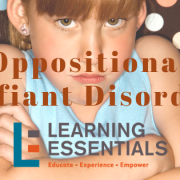Oppositional Defiant Disorder
Background
While oppositional defiant disorder (ODD) was added to the DSM in the 1980s, its existence and diagnosis is still hotly debated and somewhat misunderstood among families and educators. Surprisingly enough, ODD is one of the most common behavioral disorders to be diagnosed in children. Furthermore, researchers have also found that oppositional defiant disorder in both boys and girls is often accompanied by a previous ADHD diagnosis.
Symptoms
While ODD is a disorder that affects both boys and girls, symptoms are typically known to vary between the sexes. Though this is in no way absolute, researchers have found that boys with ODD display their opposition and defiance in more physically aggressive manners; their frustrations may escalate quickly and in more overtly explosive ways. While girls, on the other hand, are more likely to display oppositional or defiant behaviors in subtle, sneaky, or manipulative ways. For instance, girls with ODD may be deceitful or cunning and interact with others in intentionally uncooperative ways. Again, these are not hard and fast rules; they are simply some of the known observations experts have made between the genders.
It is also important to note that symptoms associated with ODD are typically misbehaviors that most children and teens will display at some point during their development. However, the difference between mere misbehaviors or teenage moodiness and ODD is the prevalence and severity of the behaviors. With regard to a diagnosis, ODD behaviors have likely become so frequent that they are deemed as the “norm” for that child.
Support in the Classroom
| Behavior | Support | Additional Considerations |
| Disproportionate anger/frustration/
irritability |
|
|
| Argumentative, uncooperative, defiant towards adults/authority figures |
|
|
| Physical aggression; vindictive, spiteful, or manipulative behavior |
|
|














